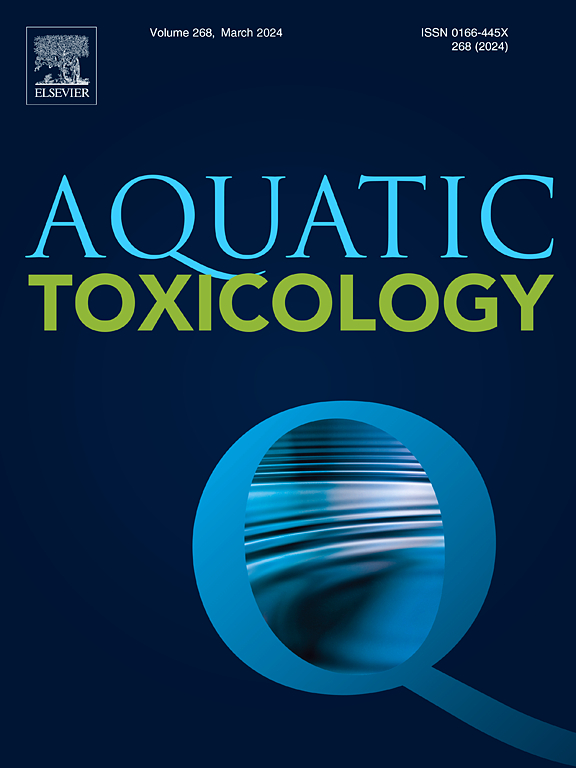The evaluations of oxidative stress and neurotoxicity in threatened endemic fish Barbus meridionalis from Osor River (Spain)
IF 4.1
2区 环境科学与生态学
Q1 MARINE & FRESHWATER BIOLOGY
引用次数: 0
Abstract
Mediterranean barbel (Barbus meridionalis) an endemic species is currently facing habitat destruction and pollution in Osor River (Spain) due to mining runoff that has severely deteriorated the water quality by metals, primarily zinc (Zn). In order to assess the potential risk of metal contamination and hydrological changes in the Osor River by using oxidative stress and neurotoxicity biomarkers via IBR analyses in the barbel, five different stations were chosen: upstream (S1: reference site and S2: hydrologically changed), mine (S3), and downstream (S4 and S5). The highest tissue metal levels were measured particularly at S3 and following downstream sites. SOD activity and the GSH system parameters (GPX, GST, and GSH) were the most sensitive oxidative stress indicators among the antioxidant system parameters. The organs with the greatest changes in antioxidant biomarkers were the liver and gill. As a sign of neurotoxicity, AChE activities significantly raised in the brain and muscle but drastically lowered in the kidney, liver, and gill particularly in the area of mine and downstream compared to reference site. Integrated biomarker response index (IBR) method was applied to visualize the affect of metal and hydrological alterations with biomarker response according to sites in the Osor River. IBR analyzes together with correlations between metal levels and oxidative stress biomarkers, emphasized that S2 and S3 have the greatest impact on the biomarker levels due to mine activity and hydrological changes highlighting the vulnerability to extinction of native fish B. meridionalis. It is also critical to assess the current data based on the multi-biomarker approach for a range of detrimental effects on fish fitness at the individual level as well as population persistence from an ecological standpoint.
对奥索尔河(西班牙)濒临灭绝的特有鱼类 Barbus meridionalis 的氧化应激和神经毒性进行评估
地中海鲃(Barbus meridionalis)是西班牙特有物种,目前在奥索尔河(西班牙)面临栖息地破坏和污染问题,原因是采矿径流造成水质严重恶化,主要是锌(Zn)等金属污染。为了通过 IBR 分析使用氧化应激和神经毒性生物标志物评估奥索尔河金属污染和水文变化的潜在风险,选择了五个不同的站点:上游(S1:参考点和 S2:水文变化)、矿区(S3)和下游(S4 和 S5)。特别是在 S3 和其后的下游站点测得的组织金属含量最高。SOD 活性和 GSH 系统参数(GPX、GST 和 GSH)是抗氧化系统参数中最敏感的氧化应激指标。抗氧化生物标志物变化最大的器官是肝脏和鳃。作为神经毒性的标志,大脑和肌肉中的乙酰胆碱酯酶活性显著升高,但肾脏、肝脏和鳃的乙酰胆碱酯酶活性却急剧下降,特别是在矿区和下游地区,与参照区相比更是如此。应用综合生物标志物反应指数(IBR)方法,可以直观地看出金属和水文变化对奥索尔河不同地点生物标志物反应的影响。IBR 分析以及金属水平和氧化应激生物标志物之间的相关性表明,由于矿山活动和水文变化,S2 和 S3 对生物标志物水平的影响最大,这凸显了本地鱼类 B. meridionalis 容易灭绝。从生态学的角度来看,评估基于多生物标志物方法的当前数据对鱼类个体健康和种群持久性的一系列有害影响也至关重要。
本文章由计算机程序翻译,如有差异,请以英文原文为准。
求助全文
约1分钟内获得全文
求助全文
来源期刊

Aquatic Toxicology
环境科学-毒理学
CiteScore
7.10
自引率
4.40%
发文量
250
审稿时长
56 days
期刊介绍:
Aquatic Toxicology publishes significant contributions that increase the understanding of the impact of harmful substances (including natural and synthetic chemicals) on aquatic organisms and ecosystems.
Aquatic Toxicology considers both laboratory and field studies with a focus on marine/ freshwater environments. We strive to attract high quality original scientific papers, critical reviews and expert opinion papers in the following areas: Effects of harmful substances on molecular, cellular, sub-organismal, organismal, population, community, and ecosystem level; Toxic Mechanisms; Genetic disturbances, transgenerational effects, behavioral and adaptive responses; Impacts of harmful substances on structure, function of and services provided by aquatic ecosystems; Mixture toxicity assessment; Statistical approaches to predict exposure to and hazards of contaminants
The journal also considers manuscripts in other areas, such as the development of innovative concepts, approaches, and methodologies, which promote the wider application of toxicological datasets to the protection of aquatic environments and inform ecological risk assessments and decision making by relevant authorities.
 求助内容:
求助内容: 应助结果提醒方式:
应助结果提醒方式:


